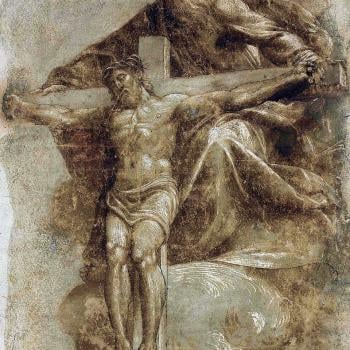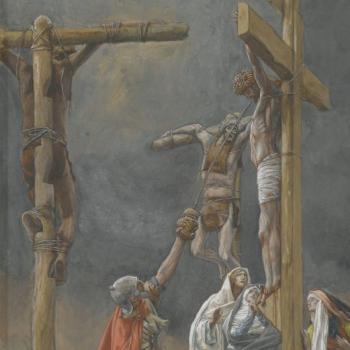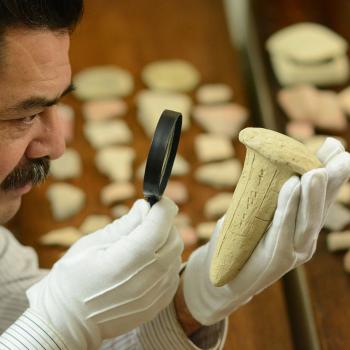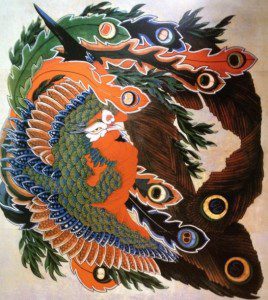 As I prepare for church this morning, I think back to two recent trips to Ganshoin, a Zen Buddhist temple in Obuse in Nagano, Japan. Those sojourns inspired conversations with Buddhists and Christians alike.
As I prepare for church this morning, I think back to two recent trips to Ganshoin, a Zen Buddhist temple in Obuse in Nagano, Japan. Those sojourns inspired conversations with Buddhists and Christians alike.
The temple is perhaps best known for famed Japanese artist Katsushiksa Hokusai’s painting of the Phoenix or “Ho-o Staring in Eight Directions.” The painting appears on the temple ceiling (pictured in this post). The temple grounds also feature the grave of daimyo Fukushima Masanori and the pond where renowned haiku poet Kobayashi Issa was inspired to write a poem about two frogs battling over a mate:
Scrawny frog,
Hang tough!
Issa is here.
痩蛙まけるな一茶是に有り yasegaeru makeru na issa kore ni ari (Refer here to the site where the poem and this translation are found). I enjoy visiting Ganshoin to view Hokusai’s painting and consider Issa’s work. This painter and poet are two of my favorites.
Something that also caught my attention was the calligraphy of Hokusai’s patron and student in Obuse, Takai Kozan. The calligraphy for the Japanese word “mu” ( 無 ) appears at the entrance to the museum. Regardless of the original intent of Takai in penning the calligraphy or its current use at the museum, I was struck by the significance of this character in Buddhist thought.
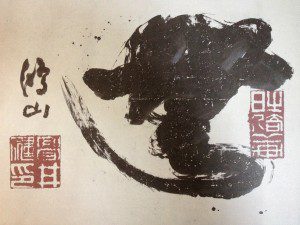
One might be led to wonder how a word often translated “nothingness” could appear in the same temple domain with a dazzling phoenix that according to one tour guide suggested fertility (See here for other uses of the phoenix: symbolizing the imperial household or heralding a new age), or with an adjoining garden and pond where two frogs fighting over a mate inspired a lively poem. But as I understand it, “mu” does not signify “empty” as in void, but rather “pregnant,” as with possibilities (notice the pictorial representation of the phoenix whose feathers are intermixed with foliage of various kinds; one guide indicated that Mount Fuji is also symbolized in the piece). Japanese Buddhist and Christian leaders with whom I spoke shared the same perspective on the word’s meaning.
According to Walpola Rahula, Gotama or Gautama Buddha taught that the soul does not endure, while the combination of physical and mental energies that constitute human life continue on long after the dissolution of the body (See Walpola Rahula, What the Buddha Taught, revised and expanded edition {New York: Grove Press, 1974}, page 33; see also page 39). Everything is always changing according to historic Buddhism. The combination of physical and mental energies to which I referred (the combination of the Five Aggregates) is born and dies every moment (See again page 33 of What the Buddha Taught). The key to realizing Nirvana is moving beyond a state of grasping where we no longer fall prey to the illusion of self (we do not annihilate self in Buddhism, for there is no self; self is illusion; see page 37 of What the Buddha Taught). Some will argue that some traditions within Japanese Buddhism affirm the permanence of the soul, including the need to pray for the souls of the deceased (a Buddhist priest at a recent ceremony in Japan in honor of a deceased loved one informed those gathered of the importance of praying for his soul); others, including a Buddhist priest with whom I spoke, maintain that belief in the soul, where it is found among common people, is simply tolerated.
One tour guide said that Hokusai may have painted the picture of the ever watchful phoenix to symbolize daimyo Fukushima Masanori’s constant and greedy gaze upon the seemingly all-powerful Tokugawa shogunate, which had reduced his wealth and influence in his later years. Who knows? But like Christianity and other religions, Buddhism views greed as negative (See the discussion of the Second Noble Truth on page 29 of What the Buddha Taught). Grasping often if not always signifies greed.
Still, Christianity and Buddhism approach the problem of greed differently. In contrast to historic Buddhism’s emphasis on the impermanence of the soul and the need to realize that all is impermanent or in flux and thus cease grasping, Christian Scripture teaches that people (including their souls) are raised immortal (See for example 1 Corinthians 15). Jesus is the resurrection and the life who provides eternal life (See John 11:25-26). The relational security that Jesus provides makes it possible for us to store up relational treasures before God as we love God with all our hearts and our neighbors as ourselves rather than pursue our own greedy self-interests (See for example Matthew 6:19-21; Mark 12:30-31).
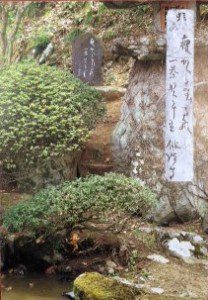
It is said that the poem by Issa to which I referred above was really about one of his children’s battles for life. Eventually, the sickly child died. Issa’s life was filled with many such moments of pain and grief. If I am not mistaken, Issa’s first wife and their children died prematurely. While still grieving the death of one of his children, Issa wrote this poem:
This dewdrop world
Is but a dewdrop world
And yet—
Issa understood the Buddhist teaching that everything is ephemeral (“mu”); and yet, still he grieved. I love Issa’s humanity, the depth of his feeling, the expression of the struggle he experienced in seeking to reconcile his faith with his suffering. If we are honest, all of us struggle in reconciling our faith and experience. “And yet,” for those of us who trust in Christ Jesus, we have hope that we will see the departed in the faith again. They are not ephemeral. They last. They endure. As Jesus said, God is the God of the living, not the dead (Mark 12:26-27).
My church does not feature a ceiling painting of the resurrection of Jesus or a phoenix rising in the heavens, for that matter. So, I will be reflecting upon Saint Paul’s words as I prepare for Sunday morning worship:
But we do not want you to be uninformed, brothers, about those who are asleep, that you may not grieve as others do who have no hope. For since we believe that Jesus died and rose again, even so, through Jesus, God will bring with him those who have fallen asleep. For this we declare to you by a word from the Lord, that we who are alive, who are left until the coming of the Lord, will not precede those who have fallen asleep. For the Lord himself will descend from heaven with a cry of command, with the voice of an archangel, and with the sound of the trumpet of God. And the dead in Christ will rise first. Then we who are alive, who are left, will be caught up together with them in the clouds to meet the Lord in the air, and so we will always be with the Lord. Therefore encourage one another with these words. (1 Thessalonians 4:13-18; ESV)
In view of this resurrection hope, I pray that I will encourage brothers and sisters in Christ who are grieving suffering and pain that it will one day cease, and invite all who do not yet know Christ to share in the fullness of his life that lasts forever.




